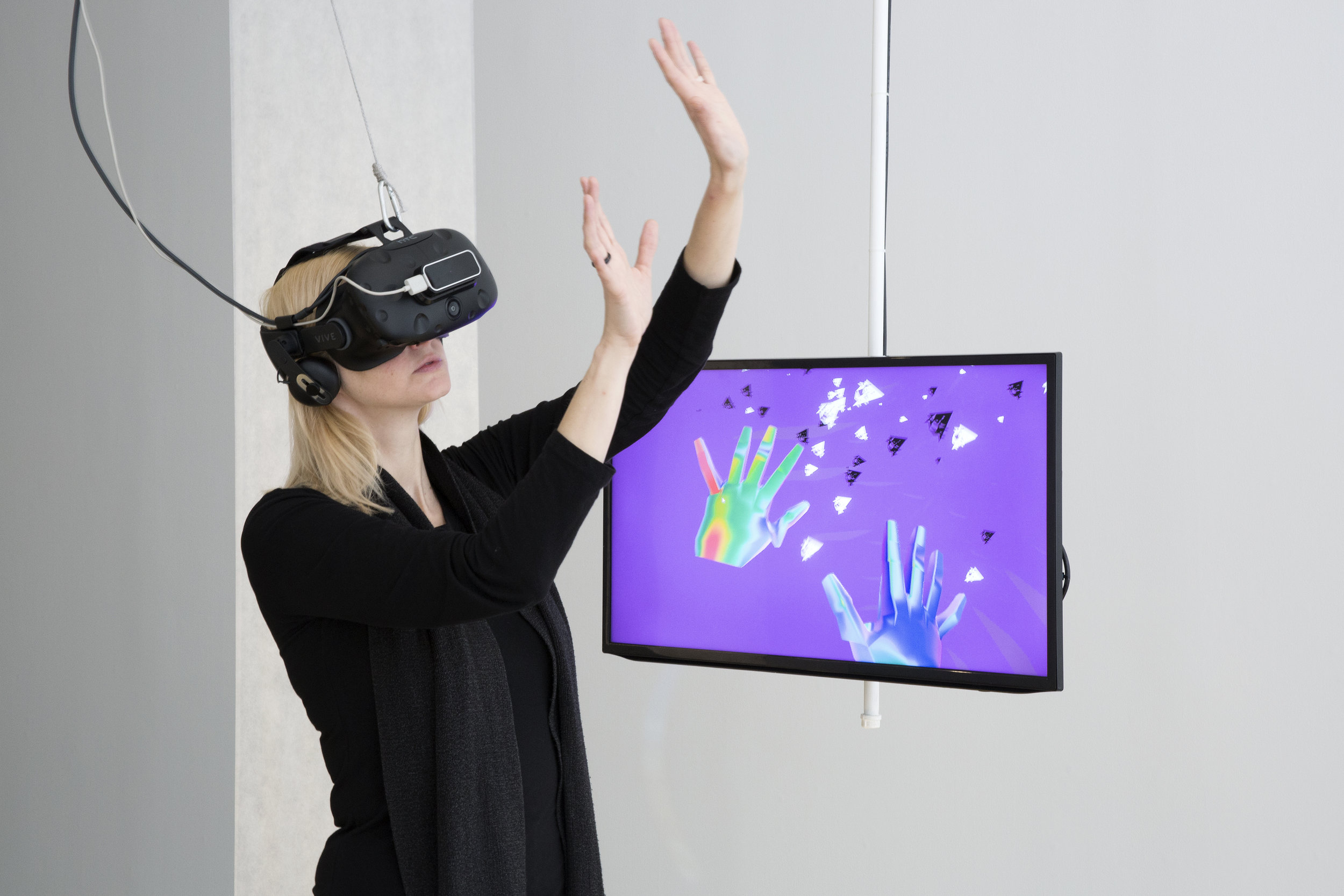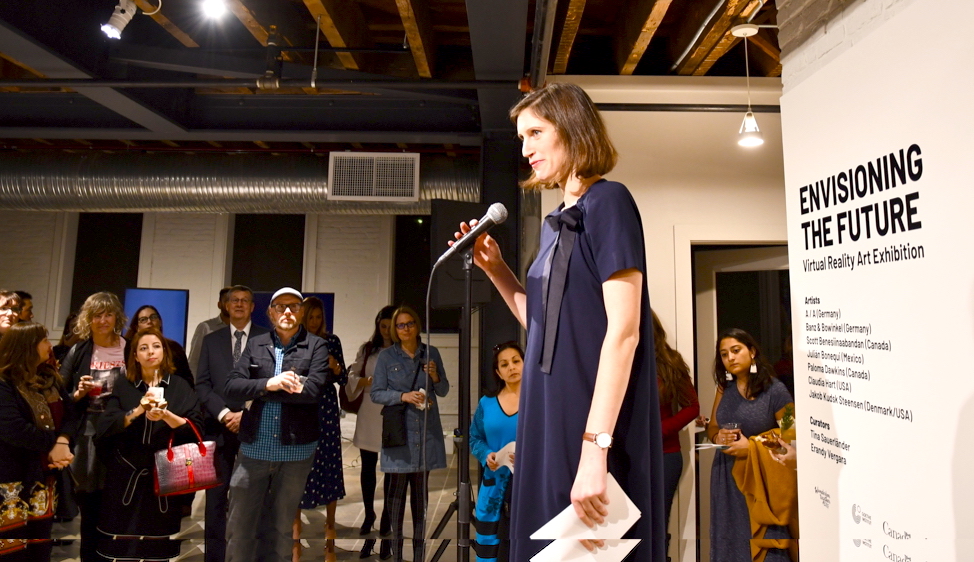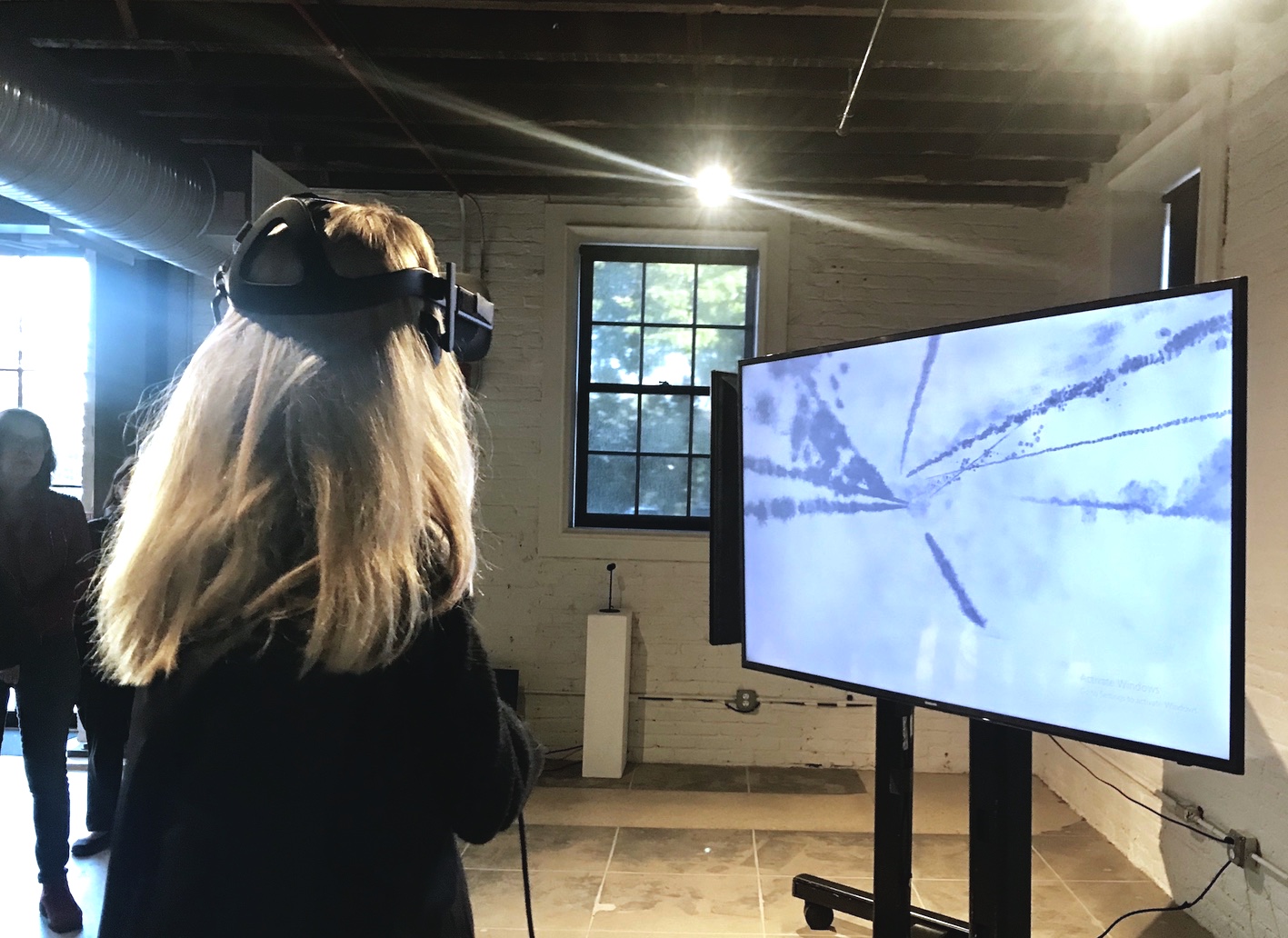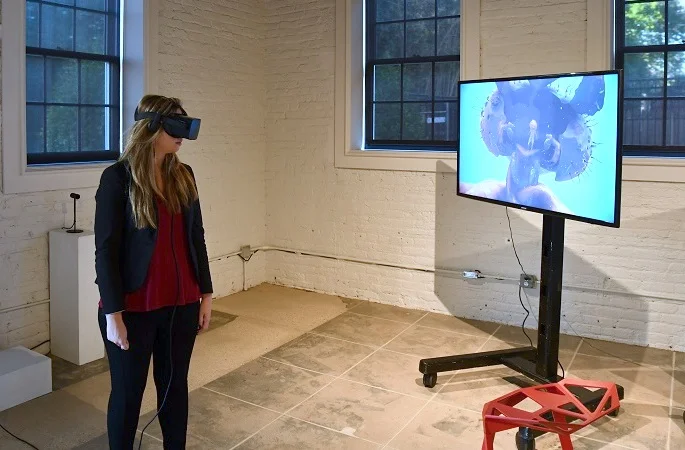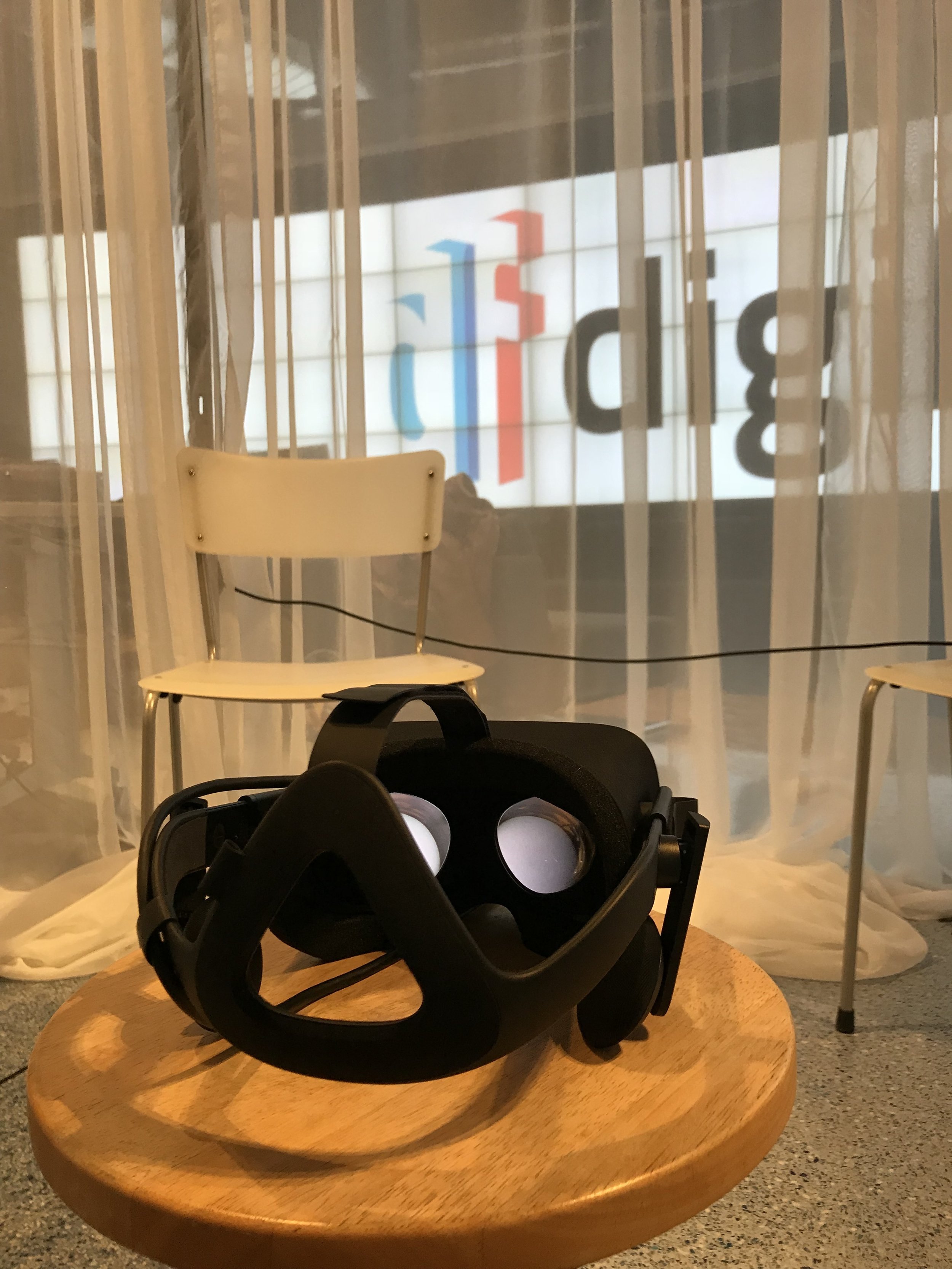SPECULATIVE CULTURES. A Virtual Reality Art Exhibition
SPECULATIVE CULTURES. A Virtual Reality Art Exhibition Documentation film by peer to space, 2019
Artists: Morehshin Allahyari (IRN/US), Scott Benesiinaabandan (CA), Matias Brunacci (ARG/DE), Yu Hong (CHN), Francois Knoetze (ZA), Erin Ko (US) and Jamie Martinez (COL/US)
Curators: Tina Sauerlaender (DE), Peggy Schoenegge (DE), and Erandy Vergara (MX/CA)
At: Anna-Maria and Stephen Kellen Gallery, Sheila C. Johnson Design Center, Parsons/The New School, New York
Opening reception: Thursday, February 7, 6-8 pm (Video)
Artist Talk: Friday, February 8, 6:30 - 7:30 pm, with Morehshin Allahyari, Erin Ko & Jamie Martinez, Francois Knoetze, moderated by Tina Sauerlaender
Duration: February 7, 2019 until April 14, 2019
Opening hours: Daily 12 noon -6 pm, Thursdays late until 8 pm Closed all major holidays.
Cultures have never existed in a set state. They are all in constant flux brought about by social, economic, and technological developments. The global flow of people forges change, adaptation of norms and the creation of new forms for human societies, religions, rituals, or spoken languages. These processes of change lead to the adoption of new tools or practices and therefore can be considered as engine for progress, growth, and innovation. The new tools of the digital age offer new possibilities for cultures to exist, evolve, and consolidate. Virtual Reality allows artists to speculate about new manifestations of cultural expressions within the conditions of the digital realm. Independent of physical surroundings, new spaces spring into existence.
The artists in this exhibition engage with their personal experiences, memories, and cultural heritage in order to reflect on today’s social coexistence. Morehshin Allahyari reflects on post-colonialism by exploring meanings of myths of Middle-Eastern origin. Scott Benesiinaabandan (CA) creates a futuristic setting based on a story of the indigenous Anishinabe peoples. Matias Brunacci develops an interactive, technology-based shamanistic journey. Yu Hong refers back to Chinese history and her families’ life stories. Francois Knoetze combines present and future, as well as representations and fictional visions of South Africa. Erin Ko and Jamie Martinez create a journey to the afterlife inspired by the Egyptian Book of the Dead.
Through their works, the artists shape their hopes and desires into virtual environments representing imagined cultures. Their speculative virtual worlds create different perspectives on established narratives and traditions, as well as images and symbols. The artists’ projects thereby open possibilities for leaving accustomed views and familiar structures behind and exploring different notions of one’s own personal surroundings and conditions of human existence.
This show is part of the exhibition series Critical Approaches in Virtual Reality Art, which was developed by Erandy Vergara and Tina Sauerlaender at the invitation of the Goethe-Institut and Studio XX in Montréal. This series brings together Erandy Vergara's engagement with postcolonial and feminist perspectives on media art and theory and Tina Sauerlaender's curatorial engagement with digital technologies and Virtual Reality.
Presented in partnership with the Consulate General of Canada in New York.
Technical expertise and support kindly provided by the XReality Center at The New School.
REVIEWS: The Observer, Antemag, No 3 Mag, WhitehotMagazine, PankMagazine
Information about each work:
Morehshin Allahyari’s series She Who Sees The Unknown re-appropriates goddesses, female jinn—supernatural or monstrous creatures in Arabian mythology—and figures of the Middle East from ancient illustrations and mythical stories. Each of these figures has its own story, which connects ancient narratives to contemporary conditions. In She Who Sees the Unknown: Ya’jooj Ma’jooj (VR Installation) the user navigates one of these stories in virtual space. The VR experience refers to a story in the Qur’an in which Zulqarnain built an iron wall between humans and the Ya’jooj and Ma’jooj people, who were troubled and needed to be separated from the human world. Allahyari imagines the wall broken and everyone becoming one and living together. By doing so, she reflects on colonialism and forms of oppression, as well as symbolic meanings of tradition and myth. Allahyari uses the virtual space to speculate on the effects of repression and cultural imprints in our lives and relates them to the digital age. Understanding technology as a philosophical toolset, the work deals with the influence of culture and myth and extends it to a speculative, digital level.
In Scott Benesiinaabandan’s Blueberry Pie Under a Martian Sky, users set off on a journey taking them seven generations into the future. They follow a boy through wormholes into an unknown world. The artwork refers to a story about spiders by Cree Elder Wilfred Buck according to which a Spider Woman wove a long thread from her home. Along this thread, the Anishinabe people travelled to Earth. The thread is often interpreted as a metaphor for wormholes, which philosophically connect two points in time. Users follow the boy as he travels back along the thread to the original place of the Anishinabe people. In his work, Benesiinaabandan reflects on the concept of time and its associated changes, especially in relation to language. Language as a key to cultural identity is also subjected to change due to the passage of time. In Benesiinaabandan’s VR work users directly experience this as they listen to the English and the Anishinabe languages simultaneously. Due to changes in technology, society, and environments over time, new words need to be created to describe new conditions.
Matias Brunacci’s Virtualshamanism takes users on a shamanistic experience in six different worlds. Each world has a particular focus and draws attention to a specific aspect of spiritual existence. Audio-visual representations thereby function as a guide to both decipher and manifest techno-spiritual and cyber-pagan problems. Based on contemporary concepts such as technoshamanism and neo-paganism, users experience worlds existing between a rational, scientific sphere and an intuitive, shamanic one. Brunacci’s work refers to Terence McKenna who understands both entheogens—psychoactive substances that induce any type of spiritual experience—and technology as extensions of human capabilities and senses. As a result of these extensions, new forms of human existence might be achieved. The artist uses VR technology as a tool for creating a digital consciousness that strives to enable us to develop a new and alternative understanding of reality, as well as human existence. Brunacci takes a speculative approach to a technological and shamanistic understanding of experience.
Yu Hong’s work She’s Already Gone places users into four moments in the life of a female Chinese protagonist. Following progressions of time that run in opposite directions, users travel with the character from birth to old age while historical time moves backward to the earliest period of Chinese history. The artist painted the images for all of the scenes in this VR artwork and then transferred them into virtual space. This process creates an interrelation between the real and virtual that is mirrored in the reverse passage of time within the narrative. In contrast to physical space, virtual space—as an experimental one—makes such a temporally contradictory juxtaposition possible. Through her use of VR technology Yu Hong illustrates how political and social changes impact individual lives. She creates a new approach to both the understanding of time and the representation of history. As a result, the artwork enables users to experience these concepts as relative and speculative.
Virtual Frontiers by Francois Knoetze is a series of six short VR films shot in multiple locations in Grahamstown (recently renamed Makhanda), South Africa. The work plays with the idea of the frontier: Grahamstown/Makhanda is a small town with a structural inheritance of Colonialism, a warped social landscape in which wealth and privilege are concentrated in one corner of the town, existing in contrast with extreme poverty. The films traverse interviews, candid footage, re-enactments, and improvised performances, combined with historical, archival documents, and digital enhancements. While representing a personal vision of the artist’s hometown, the films provide a view into the deeper problems of inequality that affect the county, charting the way class and race are mapped to geographical location. From a national monument to a boxing gym and a landfill, frontiers dissolve as the viewer encounters representations of the past, perceptions of the present, and imaginings of the future.
Inspired by the Egyptian Book of the Dead, The Neo Kingdom by Erin Ko and Jamie Martinez explores mortality and death in the digital age. A training for a challenging journey to the afterlife awaits users. Travelling through the underworld with a personalized hieroglyphic codex for navigation, they encounter Anubis, the ancient Egyptian god of death rites. In old Egypt, these codices were reserved for royalty and the upper classes. In this virtual artwork, everyone can now undertake the journey. In the exhibition space, the VR piece is embedded in an installation that represents an entrance into the spiritual world. The entire work is an imagination of the afterlife rendered possible by new technologies. It visualizes a speculative impression of the travel to the usually undocumentable experience of death. Combining traditional artistic approaches and new media, the artists create an immersive experience in both physical and virtual reality in order to reflect on possibilities of technology and our relationship to it.
Installation shots, Speculative Cultures. A Virtual Reality Exhibition (2019), curated by Tina Sauerlaender, Peggy Schoenegge, and Erandy Vergara. Anna-Maria and Stephen Kellen Gallery, Sheila C. Johnson Design Center, Parsons/The New School. Photos: Marc Tatti
Further CRITICAL APPROACHES IN VR ART Exhibitions
Curated by Tina Sauerlaender & Erandy Vergara
The exhibition series Critical Approaches in Virtual Reality Art was developed by the curators Erandy Vergara (Montréal) and Tina Sauerlaender (Berlin) at the invitation of the Goethe-Institut and Studio XX in Montréal. This series brings together Erandy Vergara's engagement with postcolonial and feminist perspectives on media art and theory and Tina Sauerlaender's curatorial engagement with digital technologies and Virtual Reality. The two curators conceived the umbrella concept Critical Approaches in VR Art to create international Virtual Reality group exhibitions that adapt to the cultural, spatial and economical conditions of the venue and its surroundings. The exhibited VR works by visual artists from different backgrounds engage critically in current political or cultural issues.
Please visit our website CriticalVR.Art for further information.
ENVISIONING THE FUTURE. Other World Perspectives in Virtual Reality Art
Artists: A / A (DE), Banz & Bowinkel (DE), Scott Benesiinaabandan (CA), Julian Bonequi (MX), Paloma Dawkins (CA), Claudia Hart (US), Jakob Kudsk Steensen (DK/US)
Curators: Erandy Vergara (MX/CA) and Tina Sauerlaender (DE)
Duration: October 23 to 28, 2018
At: Halcyon Arts Lab, 1801 35th Street NW, Washington, DC
The future no longer exists solely within the bounds of the “real” world. In a time of political tension between communities, countries, and cultures, we are now redefining and reexamining our future in both real and virtual spaces. You are invited to experience the future as it is imagined by seven artists who have rendered their unique visions of tomorrow using the medium of Virtual Reality, thus forging deeper connections between technology and art. In Envisioning the Future – Other World Perspectives in Virtual Reality Art, these seven artists use Virtual Reality to transport us to vastly different parallel futuristic worlds: from utopian to apocalyptic, from primeval to high-tech, from Earth to Mars. Simultaneously fascinated by and fearful of the future, our curiosity and the spirit of discovery drive our visions of a future that we are all actively part of. Placing the viewer in an active role that allows them to help shape the space they occupy, Virtual Reality makes the individual the center of an artistic piece, an active “user” who decides where to look and where to go.
Partners:
Li Alin, Erin Gee & Alex Lee
H.E.A.R.T. by Erin Gee and Alex M. Lee
Enter Me Tonight by Li Alin
Presented by the Goethe-Institut Toronto
Curated by Tina Sauerländer (Berlin) and Erandy Vergara (Montreal)
At: Digifest Toronto, CORUS QUAY, 25 Dockside Dr, ON M5A 1B6 Toronto
At the invitation of the Goethe-Institut curators Tina Sauerländer and Erandy Vergara have selected VR works for this year’s Toronto Digifest, including two recent pieces by Berlin-based Canadian artist Li Alin and Montreal-based artist Erin Gee in collaboration with South Korean-born, US-based artist Alex M. Lee. The artists use humor and irony to engage in controversial topics: emotions in first-person shooter video games and war in the case of Gee, and a futuristic exploration on human reproduction in technology-oriented times in the case of Alin. The audience itself explores Gee's H.E.A.R.T., a virtual work where you have to control your emotions to control the leading character in a war-related VR game, as well as Alin's Enter Me Tonight, a VR environment engaged with issues on human reproduction, economy, biology, pornography and technology. In a contextualizing event on April 26, 3 pm, the curators will speak about the history of VR and current trends and critical perspectives on this technology.
With Enter Me Tonight (EMT), Li Alin recreates a world where women reflect and take action to upgrade the reproductive system that seems to become more and more artificial and inhuman. Entwined around a main character, DeNA, it talks about reproduction methods, improving dysfunctional reproductive systems and new evolutionary strategies that emphasize the role of women and female orgasm.
Erin Gee & Alex M. Lee: H.E.A.R.T. is a code name for the Holographic Empathy Attack Robotics Team, a biosensor-driven virtual reality artwork Gee developed in collaboration with 3D-artist Alex M. Lee. H.E.A.R.T. invites the viewer to place their fingers on a biodata gathering device and then summon their enthusiasm in order to direct their avatar in “combat therapy.”


